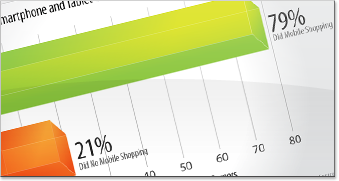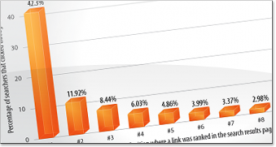Even if you aren’t actively participating in online sales there are compelling reasons why you should consider optimizing your products or retail locations to capitalize on the shopping trends of modern day shoppers. If you are an online retailer you cannot afford not to mobilize your content. Recent research performed by the Nielsen company shows that 79% of smartphone and tablet owners have used their mobile devices to engaging in mobile shopping.
Before we delve too far into this, however, I think we need to establish some key foundation points when discussing mobile devices. All mobile devices are not created equal. A consumer is going to utilize a smartphone in a different way than they would a tablet. Why you ask? Two primary reasons, location and form factor (most people aren’t going to throw a tablet into their pocket or purse). Keep this in mind when considering how you are going to implement portions of your optimization plan. While many people bundle all mobile devices together, there are times when splitting the functionality and look of these elements can be in your overall best interest. We are going to take a look at the categories of the Nielsen research and break them down into how these relate into both brick and mortal mobile optimization and online mobile optimization.
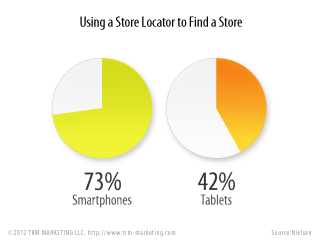 Using a Store Locator to Find a Store
Using a Store Locator to Find a Store
73% of smartphone users and 42% of tablet users used a store locator on a mobile device. This is especially critical for retail locations or manufacturers that sell out of multiple locations. The 31% increase of smartphones over tablets suggests that these are customers on the go who are probably pretty deep in the sales cycle. These are customers who are as close to making a purchase as you can get them, so make sure this is as easy as possible. That means don’t ask for any information that is not absolutely necessary to give them the information they want! Tying this in with geo-location (built in GPS) on a device is a great option.
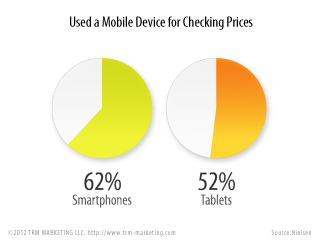 Checking Prices
Checking Prices
62% of smartphone and 52% of tablet users report using their mobile devices to check prices before shopping. People are becoming more and more savvy shoppers. Gone are the days of attracting customers with the flashy Sunday shopper ads in the local newspaper. Your customers, whether they are online or walk-in traffic, will do research so make sure your prices are competitive for the services/products you offer.
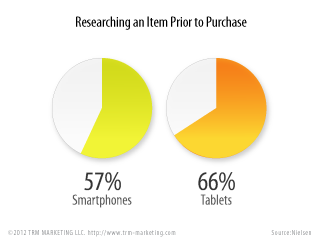 Researching an Item Prior to Purchase
Researching an Item Prior to Purchase
57% of smartphone and 66% of tablet users surveyed researched products prior to purchase. Make it easy on your customers, help them find relevant and honest information. For brick and mortar locations, this could be as easy as setting up QR Codes that link directly to custom reviews of a product. For online locations, consider tying your website into existing sources of information to keep your customers on site and shopping. If you need a QR Code generator please don't hesitate to use ours. It is free as well as easy to use and includes a URL plus Google Analytics option so you can track the effects of your marketing efforts.
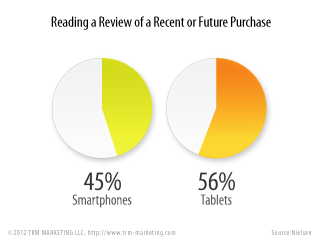 Reading Reviews of a Recent or Future Purchase
Reading Reviews of a Recent or Future Purchase
45% of smartphone and 56% of tablet users read reviews of products of recent purchases, or for purchases they plan to make. In an online environment this is as easy as including customer reviews of a product on the same page and displaying product average ratings when available. Some online retailers attempt to limit bad reviews but this is not an approach I would recommend. Instead, embrace the power of the masses and remove products that have low ratings before they damage the relationship with your existing customers. When it comes to traditional brick and mortal sales, integrating customer reviews can be a little more work but can be accomplished with a multi-channel approach.
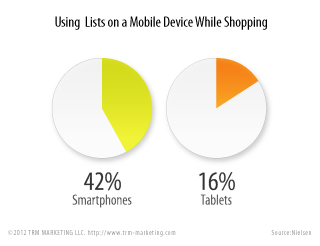 Using Lists while Shopping
Using Lists while Shopping
42% of smartphones and 16% of tablet users used lists on mobile devices while shopping. This is important, especially for retailers that list products online but provide their products in a brick and mortar storefront. Lists are great and powerful things that prevent customers from forgetting to purchase items, and as such, you need to embrace this. Provide customers with a way to either easily save or e-mail themselves a list of products they found via your website. If a customer forgets it at your store there is no guarantee they won't stop somewhere else to pick it up. The data you collect from letting your customer generate lists will allow you to more accurately target customers with relevant specials in the future with targeted emails for products they use!
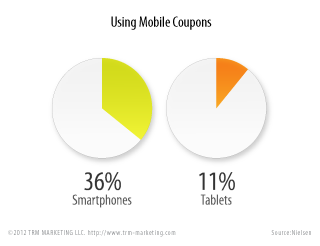 Using Mobile Coupons
Using Mobile Coupons
36% of smartphone and 11% of tablet users reported using a mobile coupon when making a purchase. While there are a number of ways to issue mobile coupons, some of the easiest methods are creating signup forms on your website, or submitting the coupons to online companies such as Yowza. The big thing here is retailers need to rethink how they redeem coupons. Tying in barcodes that can be displayed on a mobile device is a great way to ensure you are collecting customer data while providing customers with the satisfaction of getting a great deal.
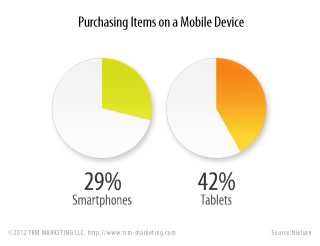 Purchasing an Item on a Device
Purchasing an Item on a Device
29% of smartphone and 42% of tablet users purchased items directly through their device. If you run any kind of e-commerce platform, you need to ensure customers can easily navigate and, more importantly, easily check out on from mobile devices. Here is one of those situations where you should make sure the process is targeted to the device. Smartphones have a small display, so a more vertical approach might be in order than when compared to a tablet. Remember, people want fast and simple so keep the information to only what is absolutely required.
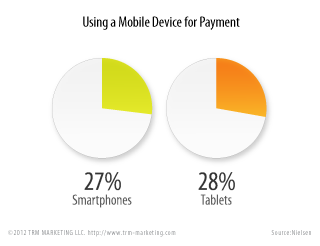 Using a Device for Payment
Using a Device for Payment
27% of smartphone and 28% of tablet users used their devices for payment. While relatively new, these are becoming more popular. Think of the e-wallet by Google http://www.google.com/wallet/ or direct mobile billing. While this is relatively new more people have begun utilizing this for a payment method, especially on smaller regular purchases, such as daily coffee house trips.
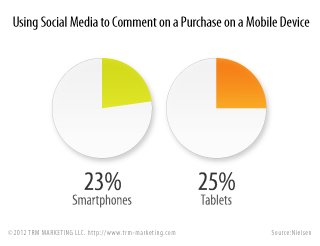 Using Social Media to Comment on a Purchase
Using Social Media to Comment on a Purchase
23% of smartphone and 25% of tablet users commented on purchases with social media. While a study by Lightspeed Online Research Inc. showed that consumers only rely on social media reviews about 7% of the time prior to making a purchase, one cannot discount the group mentality of social networks. Generally, people communicate with like-minded individuals. So, while they might not consider the review, the brand exposure has the potential of hitting on a key target market.
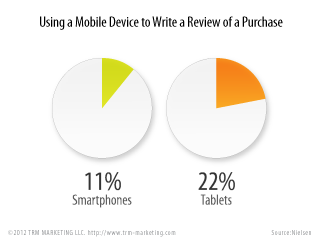 Writing a Review of a Purchase
Writing a Review of a Purchase
11% of smartphone and 22% of tablet users wrote a review of a purchase. When you consider the implications of local search and the relevance companies such as Google place on customer reviews, this is an essential factor to master for your business. Brick and mortar stores pushing customers to post reviews can have significant impact, both online and in the cash register.

